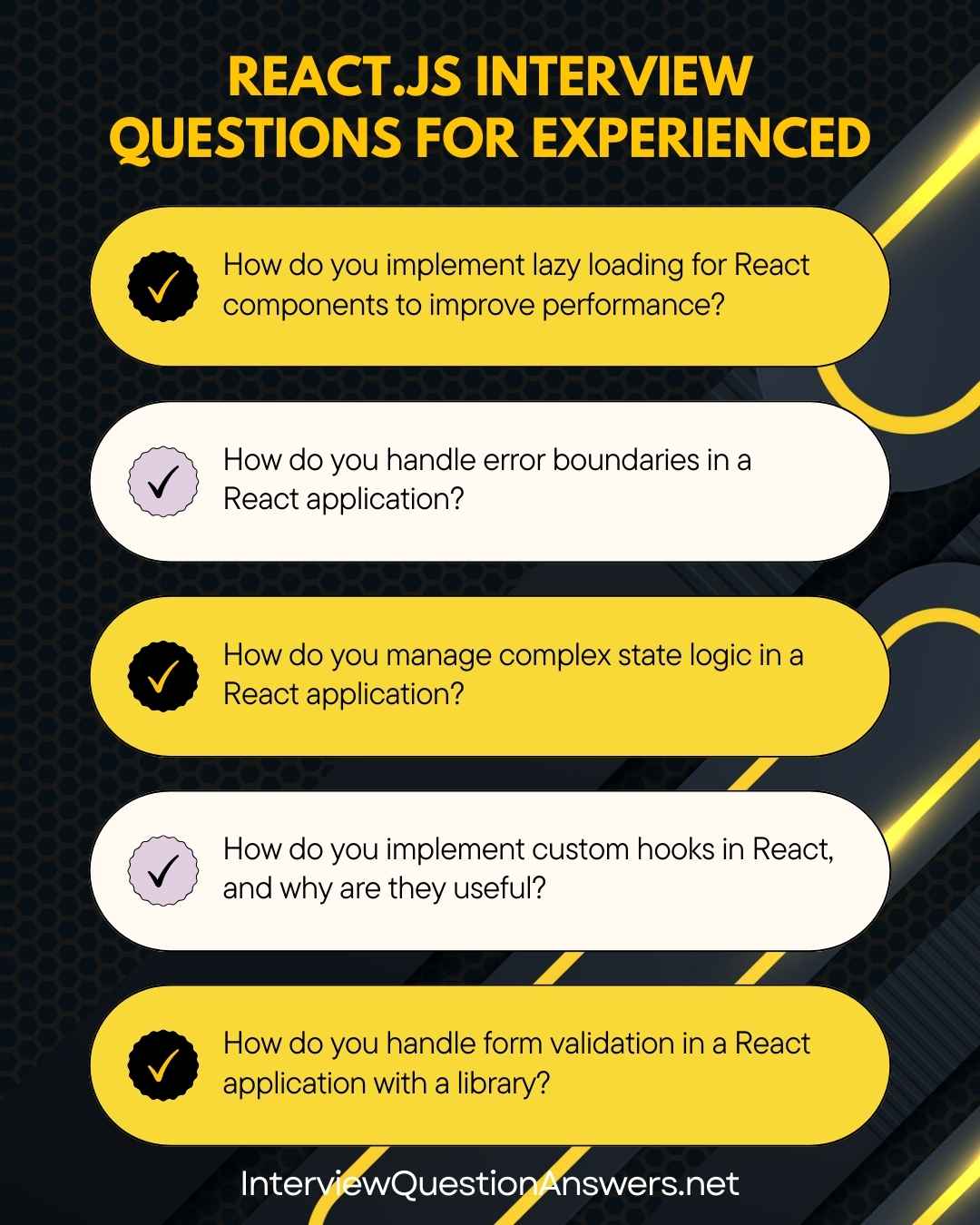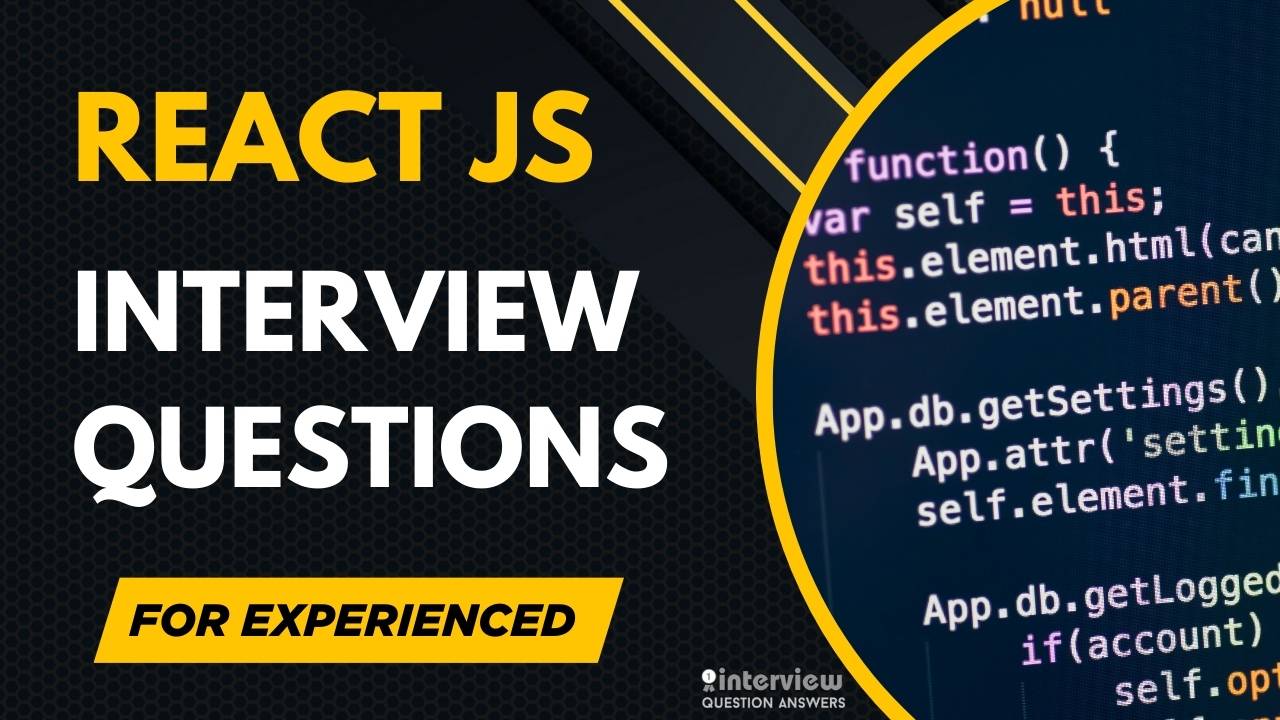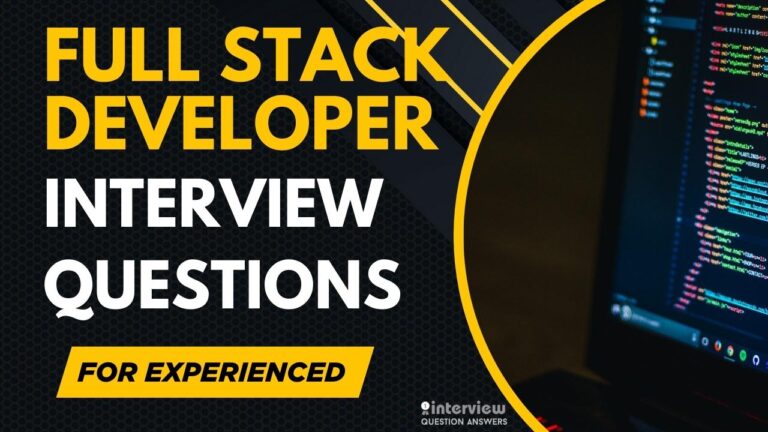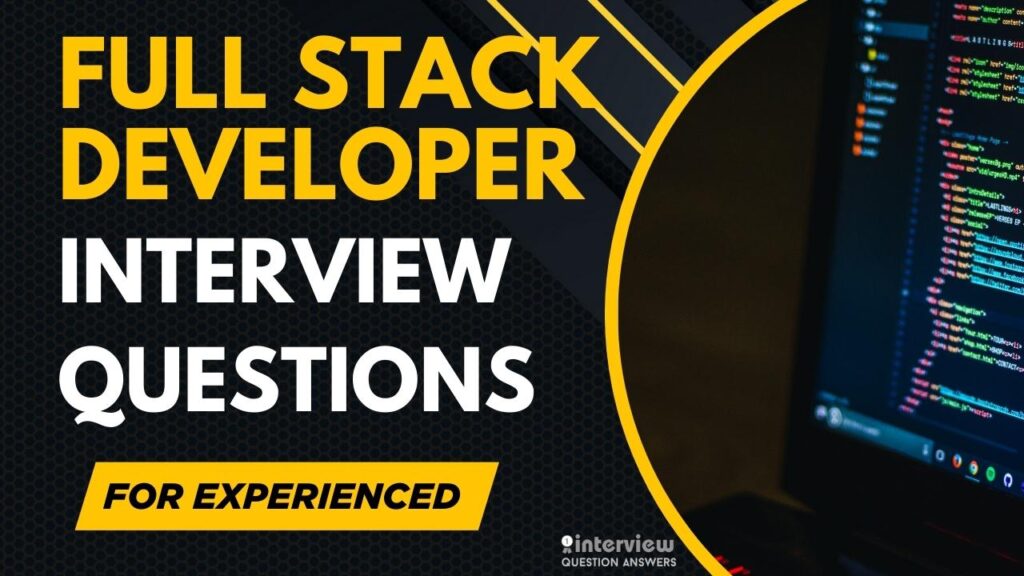Top 50 React JS Interview Questions for Experienced
React JS Interview Questions for Experienced professionals focus on advanced React patterns, performance optimization techniques, and architectural decision-making that seasoned developers must demonstrate. Advancing to senior React positions requires showcasing deep expertise in component design systems and scalable application architecture beyond foundational skills.
This interview guide covers React Interview Questions for Experienced candidates with multiple years of industry experience, addressing advanced hooks patterns, state management solutions, micro-frontend architectures, and team leadership scenarios.
These React.JS Interview Questions for Experienced professionals will help you showcase your expertise, demonstrate complex application optimization, and prove your readiness for senior frontend development roles in today’s competitive React ecosystem.
You can also check: React JS Interview Questions and Answers PDF
Table of Contents
React Interview Questions for 2 Years Experience
Que 1. How do you optimize React component performance for a large dataset?
Answer:
Use memoization with React.memo for functional components to prevent unnecessary re-renders. Implement pagination or infinite scrolling with libraries like react-window to render only visible items. Optimize state updates with useCallback and useMemo to avoid redundant computations, and profile with React DevTools to identify bottlenecks.
Que 2. How do you manage state in a React application with multiple components?
Answer:
Use useState for local state and useReducer for complex state logic. For global state, leverage Context API or libraries like Redux. Pass state via props for small apps, and use Redux Toolkit for scalable state management with middleware like redux-thunk for async actions.
Que 3. What is the difference between controlled and uncontrolled components in React?
Answer:
Controlled components have their form data managed by React state (e.g., value and onChange for inputs), ensuring predictable updates. Uncontrolled components rely on DOM state, accessed via refs (e.g., useRef). Controlled components are preferred for dynamic forms, while uncontrolled are simpler for static inputs.
// Controlled
const [value, setValue] = useState("");
<input value={value} onChange={(e) => setValue(e.target.value)} />
// Uncontrolled
const inputRef = useRef(null);
<input ref={inputRef} />Que 4. How do you handle side effects in a React functional component?
Answer:
Use the useEffect hook to handle side effects like API calls or DOM updates. Specify dependencies in the dependency array to control when the effect runs. Clean up resources (e.g., timers, subscriptions) in the cleanup function to prevent memory leaks.
useEffect(() => {
const timer = setInterval(() => console.log("Tick"), 1000);
return () => clearInterval(timer); // Cleanup
}, []);Que 5. How do you implement routing in a React application?
Answer:
Use react-router-dom for routing. Install the package, set up a BrowserRouter, and define routes with Route components. Use Link for navigation and useParams or useNavigate for dynamic routing.
import { BrowserRouter, Route, Routes, Link } from 'react-router-dom';
function App() {
return (
<BrowserRouter>
<Routes>
<Route path="/" element={<Home />} />
<Route path="/about" element={<About />} />
</Routes>
<Link to="/about">Go to About</Link>
</BrowserRouter>
);
}Que 6. What are React Hooks, and how do they differ from class-based lifecycle methods?
Answer:
Hooks are functions (e.g., useState, useEffect) that enable state and lifecycle features in functional components. Unlike class-based lifecycle methods (componentDidMount, componentDidUpdate), Hooks are more concise, reusable, and avoid this binding issues. For example, useEffect combines multiple lifecycle methods into one.
Que 7. How do you prevent unnecessary re-renders in a React application?
Answer:
Use React.memo for components with static props, useCallback for memoized event handlers, and useMemo for expensive computations. Split large components into smaller ones and manage state efficiently with Context or Redux to minimize re-rendering cascades.
const MemoizedComponent = React.memo(({ data }) => <div>{data}</div>);Que 8. How do you fetch data from an API in a React component?
Answer:
Use useEffect with fetch or libraries like axios for API calls. Store data in state with useState, handle loading and error states, and ensure cleanup to avoid memory leaks.
import { useState, useEffect } from 'react';
function DataComponent() {
const [data, setData] = useState(null);
useEffect(() => {
fetch('https://api.example.com/data')
.then(res => res.json())
.then(setData)
.catch(err => console.error(err));
}, []);
return <div>{data ? data.name : 'Loading...'}</div>;
}Que 9. How do you handle forms in React with validation?
Answer:
Use controlled components with useState for form inputs and validate on onChange or onSubmit. Libraries like formik or react-hook-form simplify validation and submission handling with built-in schemas (e.g., Yup).
import { useState } from 'react';
function Form() {
const [form, setForm] = useState({ email: '' });
const handleSubmit = (e) => {
e.preventDefault();
if (!form.email.includes('@')) alert('Invalid email');
};
return (
<form onSubmit={handleSubmit}>
<input
value={form.email}
onChange={(e) => setForm({ email: e.target.value })}
/>
<button type="submit">Submit</button>
</form>
);
}Que 10. How do you use Context API to manage global state in React?
Answer:
Create a context with createContext, provide state with a Provider, and consume it using useContext or Consumer. Use for app-wide data like themes or user info, avoiding prop drilling.
import { createContext, useContext } from 'react';
const ThemeContext = createContext();
function App() {
return (
<ThemeContext.Provider value="dark">
<Child />
</ThemeContext.Provider>
);
}
function Child() {
const theme = useContext(ThemeContext);
return <div>Theme: {theme}</div>;
}React Interview Questions for 3 Years Experience
Que 11. How do you implement lazy loading for React components to improve performance?
Answer:
Use React.lazy() with Suspense to dynamically import components, reducing initial bundle size. Wrap lazy-loaded components in Suspense with a fallback UI for loading states. Combine with react-router-dom for route-based code splitting.
import { lazy, Suspense } from 'react';
import { BrowserRouter, Route, Routes } from 'react-router-dom';
const LazyComponent = lazy(() => import('./LazyComponent'));
function App() {
return (
<BrowserRouter>
<Suspense fallback={<div>Loading...</div>}>
<Routes>
<Route path="/lazy" element={<LazyComponent />} />
</Routes>
</Suspense>
</BrowserRouter>
);
}Que 12. How do you handle error boundaries in a React application?
Answer:
Implement error boundaries using class components with static getDerivedStateFromError() and componentDidCatch() or use libraries like react-error-boundary for functional components. Wrap components to catch and display fallback UI for errors.
import { Component } from 'react';
class ErrorBoundary extends Component {
state = { hasError: false };
static getDerivedStateFromError() {
return { hasError: true };
}
componentDidCatch(error, info) {
console.error(error, info);
}
render() {
return this.state.hasError ? <div>Error occurred</div> : this.props.children;
}
}
function App() {
return <ErrorBoundary><ChildComponent /></ErrorBoundary>;
}Que 13. How do you optimize React applications for SEO?
Answer:
Use server-side rendering (SSR) with Next.js or ReactDOMServer to pre-render content for crawlers. Implement meta tags with react-helmet, ensure static routes for key pages, and use sitemap.xml and robots.txt. Optimize performance with lazy loading and prerendering for faster indexing.
import { Helmet } from 'react-helmet';
function Page() {
return (
<>
<Helmet>
<title>My Page Title</title>
<meta name="description" content="Page description" />
</Helmet>
<div>Content</div>
</>
);
}Que 14. How do you manage complex state logic in a React application?
Answer:
Use useReducer for complex state transitions, combining with Context API for global state. For larger apps, integrate Redux Toolkit with slices for modular state management. Use middleware like redux-thunk for async logic and useSelector for efficient state access.
import { useReducer } from 'react';
const initialState = { count: 0 };
function reducer(state, action) {
switch (action.type) {
case 'increment': return { count: state.count + 1 };
default: return state;
}
}
function Counter() {
const [state, dispatch] = useReducer(reducer, initialState);
return <button onClick={() => dispatch({ type: 'increment' })}>{state.count}</button>;
}Que 15. How do you implement custom hooks in React, and why are they useful?
Answer:
Custom hooks are reusable functions that encapsulate logic using built-in hooks like useState or useEffect. They promote code reuse and separation of concerns, making components cleaner and easier to test.
import { useState, useEffect } from 'react';
function useFetch(url) {
const [data, setData] = useState(null);
useEffect(() => {
fetch(url).then(res => res.json()).then(setData);
}, [url]);
return data;
}
function Component() {
const data = useFetch('https://api.example.com/data');
return <div>{data ? data.name : 'Loading...'}</div>;
}Que 16. How do you handle authentication in a React application?
Answer:
Store authentication tokens in localStorage or HTTP-only cookies for security. Use Context API to manage auth state globally, protect routes with PrivateRoute components, and refresh tokens with interceptors (e.g., axios). Integrate with OAuth providers like Auth0 for robust authentication.
import { createContext, useContext } from 'react';
const AuthContext = createContext();
function App() {
const [user, setUser] = useState(null);
return (
<AuthContext.Provider value={{ user, setUser }}>
<PrivateRoute component={Dashboard} />
</AuthContext.Provider>
);
}Que 17. How do you test React components effectively?
Answer:
Use Jest with React Testing Library for unit and integration tests. Test rendering with render(), simulate events with fireEvent, and verify output with screen. Mock API calls with msw and test hooks with @testing-library/react-hooks. Aim for high coverage while focusing on critical paths.
import { render, screen } from '@testing-library/react';
import MyComponent from './MyComponent';
test('renders button', () => {
render(<MyComponent />);
expect(screen.getByText('Click Me')).toBeInTheDocument();
});Que 18. How do you handle form validation in a React application with a library?
Answer:
Use react-hook-form or formik with Yup for schema-based validation. Bind form inputs to the library’s state, define validation rules, and display errors dynamically. This reduces boilerplate and improves performance compared to manual validation.
import { useForm } from 'react-hook-form';
function Form() {
const { register, handleSubmit, formState: { errors } } = useForm();
const onSubmit = data => console.log(data);
return (
<form onSubmit={handleSubmit(onSubmit)}>
<input {...register('email', { required: true, pattern: /@./ })} />
{errors.email && <span>Email is invalid</span>}
<button type="submit">Submit</button>
</form>
);
}Que 19. How do you integrate WebSockets in a React application for real-time updates?
Answer:
Use the WebSocket API or libraries like socket.io-client. Initialize the WebSocket connection in useEffect, handle messages with event listeners, and update state with useState. Ensure cleanup to close connections on component unmount.
import { useState, useEffect } from 'react';
import io from 'socket.io-client';
function RealTimeComponent() {
const [message, setMessage] = useState('');
useEffect(() => {
const socket = io('https://server.example.com');
socket.on('message', data => setMessage(data));
return () => socket.disconnect();
}, []);
return <div>{message}</div>;
}Que 20. How do you manage CSS in a React application to avoid style conflicts?
Answer:
Use CSS-in-JS libraries like styled-components or emotion for scoped styles, or CSS Modules for modular imports. Alternatively, use Tailwind CSS for utility-based styling. Avoid global CSS to prevent conflicts, and leverage classnames for conditional styling.
import styled from 'styled-components';
const Button = styled.button`
background: blue;
color: white;
`;
function Component() {
return <Button>Click Me</Button>;
}
Also Check: React interview questions for Freshers
React Interview Questions for 5 Years Experience
Que 21. How do you optimize a React application for large-scale, data-intensive dashboards?
Answer:
Optimize by using React.memo to prevent unnecessary re-renders, implementing virtualization with react-window or react-virtualized for large datasets, and leveraging useMemo for expensive computations. Use server-side rendering (SSR) with Next.js for initial load performance, integrate lazy loading for components, and optimize API calls with caching (e.g., SWR or React Query). Monitor with React Profiler to identify bottlenecks.
Que 22. How do you implement a global state management solution in a large React application?
Answer:
Use Redux Toolkit for scalable state management with slices to modularize state logic. Combine with redux-persist for local storage and redux-thunk or redux-saga for async operations. Alternatively, use Zustand for lightweight state management or Recoil for atomic state updates, ensuring minimal re-renders with selective subscriptions via useSelector.
Que 23. How do you handle complex form state with dynamic fields in React?
Answer:
Use react-hook-form with dynamic field arrays for scalability and performance, integrating Yup for schema validation. Manage form state with a single useForm hook, handle dynamic fields with useFieldArray, and optimize re-renders by isolating form logic. For complex forms, consider splitting into smaller components with Context for shared state.
import { useForm, useFieldArray } from 'react-hook-form';
function DynamicForm() {
const { register, control, handleSubmit } = useForm();
const { fields, append } = useFieldArray({ control, name: 'items' });
return (
<form onSubmit={handleSubmit(data => console.log(data))}>
{fields.map((field, index) => (
<input key={field.id} {...register(`items.${index}.value`)} />
))}
<button type="button" onClick={() => append({ value: '' })}>Add</button>
<button type="submit">Submit</button>
</form>
);
}Que 24. How do you implement server-side rendering (SSR) in a React application, and what are the benefits?
Answer:
Use Next.js for SSR, configuring getServerSideProps to fetch data on each request. Benefits include improved SEO, faster initial page loads, and better user experience. Optimize by caching data with Redis or getStaticProps for static generation, and handle hydration errors with proper state management.
export async function getServerSideProps() {
const data = await fetch('https://api.example.com/data').then(res => res.json());
return { props: { data } };
}
function Page({ data }) {
return <div>{data.name}</div>;
}Que 25. How do you secure a React application against common vulnerabilities like XSS or CSRF?
Answer:
Prevent XSS by sanitizing inputs with libraries like DOMPurify and avoiding dangerouslySetInnerHTML. For CSRF, use HTTP-only cookies for tokens, implement CSRF tokens with APIs, and leverage fetch with credentials: 'include'. Secure API calls with JWT or OAuth, and use Helmet in Next.js to set secure headers.
Que 26. How do you implement real-time features in a React application using WebSockets?
Answer:
Use socket.io-client or native WebSocket API, initializing connections in useEffect. Manage real-time state with useState, handle reconnection logic, and ensure cleanup on unmount. For scalability, integrate with a backend like Node.js and use Redis for pub/sub in distributed systems.
import { useState, useEffect } from 'react';
import io from 'socket.io-client';
function RealTime() {
const [messages, setMessages] = useState([]);
useEffect(() => {
const socket = io('https://server.example.com');
socket.on('message', msg => setMessages(prev => [...prev, msg]));
return () => socket.disconnect();
}, []);
return <div>{messages.map(msg => <p>{msg}</p>)}</div>;
}Que 27. How do you manage and optimize bundle size in a large React application?
Answer:
Analyze bundle size with webpack-bundle-analyzer, use code splitting with React.lazy and Suspense, and tree-shake unused code with ES modules. Minimize dependencies, compress assets with Brotli, and use dynamic imports for routes or heavy components to reduce initial load time.
import { lazy, Suspense } from 'react';
const HeavyComponent = lazy(() => import('./HeavyComponent'));
function App() {
return <Suspense fallback={<div>Loading...</div>}>
<HeavyComponent />
</Suspense>;
}Que 28. How do you handle unit testing for complex React components with hooks?
Answer:
Use Jest with @testing-library/react for testing. Mock hooks with @testing-library/react-hooks, simulate user interactions with fireEvent or userEvent, and mock APIs with msw. Test edge cases, state changes, and side effects, ensuring high coverage with tools like Istanbul.
import { render, screen } from '@testing-library/react';
import { useCustomHook } from './hooks';
jest.mock('./hooks');
test('renders component', () => {
useCustomHook.mockReturnValue({ data: 'test' });
render(<MyComponent />);
expect(screen.getByText('test')).toBeInTheDocument();
});Que 29. How do you integrate TypeScript into a React application for type safety?
Answer:
Add TypeScript with create-react-app --template typescript or install typescript and tsconfig.json. Define interfaces for props and state, use React.FC for functional components, and type API responses. Use ts-jest for testing and enforce strict typing to catch errors early.
interface Props {
name: string;
}
const MyComponent: React.FC<Props> = ({ name }) => {
return <div>{name}</div>;
};Que 30. How do you implement accessibility (a11y) in a React application?
Answer:
Follow WCAG guidelines, use semantic HTML, and add ARIA attributes with react-aria or native roles. Ensure keyboard navigation with tabIndex, test with tools like axe-core, and provide alt text for images. Use eslint-plugin-jsx-a11y to enforce accessibility rules during development.
import { useRef } from 'react';
function AccessibleButton() {
const buttonRef = useRef(null);
return (
<button ref={buttonRef} aria-label="Submit form" onClick={() => buttonRef.current.focus()}>
Submit
</button>
);
}Also Check: ExpressJS Interview Questions and Answers PDF
React JS Interview Questions for 7 Years Experience
Que 31. How do you handle performance issues in a React application with frequent state updates?
Answer:
Use useMemo and useCallback to memoize values and functions, preventing unnecessary re-renders. Split components to isolate state changes, use Redux Toolkit’s createSelector for memoized selectors, and batch updates with React 18’s automatic batching. Profile with React DevTools to optimize.
Que 32. How do you implement a custom render prop pattern in React?
Answer:
Create a component that accepts a function as a prop to render dynamic UI based on internal state or logic. This pattern enhances reusability and flexibility, allowing consumers to define custom rendering logic.
function DataFetcher({ render }) {
const [data, setData] = useState(null);
useEffect(() => {
fetch('https://api.example.com/data')
.then(res => res.json())
.then(setData);
}, []);
return render(data);
}
function App() {
return <DataFetcher render={data => <div>{data?.name}</div>} />;
}Que 33. How do you manage API caching in a React application?
Answer:
Use libraries like SWR or React Query for client-side caching and automatic refetching. Configure cache policies (e.g., stale-while-revalidate), use useSWR for data fetching, and integrate with local storage for persistent caching. Optimize with deduping to reduce API calls.
import useSWR from 'swr';
const fetcher = url => fetch(url).then(res => res.json());
function Component() {
const { data, error } = useSWR('https://api.example.com/data', fetcher);
if (error) return <div>Error</div>;
if (!data) return <div>Loading...</div>;
return <div>{data.name}</div>;
}Que 34. How do you handle internationalization (i18n) in a React application?
Answer:
Use react-i18next or react-intl for internationalization. Store translations in JSON files, initialize i18next with language detection, and use useTranslation hook for dynamic text. Support RTL layouts with CSS and test with multiple locales.
import { useTranslation } from 'react-i18next';
function Component() {
const { t } = useTranslation();
return <div>{t('welcome')}</div>;
}Que 35. How do you migrate a React class-based application to functional components?
Answer:
Replace class components with functional components, convert state to useState, and lifecycle methods to useEffect. Refactor this bindings to hooks like useCallback, update tests with @testing-library/react, and incrementally migrate to avoid regressions, ensuring compatibility with existing props.
Que 36. How do you implement a micro-frontend architecture with React?
Answer:
Use frameworks like single-spa or Module Federation in Webpack 5 to split React apps into micro-frontends. Share dependencies via module federation, manage cross-app communication with events or shared state, and deploy independently. Ensure consistent styling with CSS-in-JS or utility frameworks like Tailwind.
Que 37. How do you handle memory leaks in a React application?
Answer:
Avoid memory leaks by cleaning up side effects in useEffect (e.g., timers, subscriptions). Use useRef for persistent references, cancel async operations with AbortController, and monitor memory usage with Chrome DevTools. Ensure components unmount properly to release resources.
useEffect(() => {
const controller = new AbortController();
fetch('https://api.example.com/data', { signal: controller.signal })
.then(res => res.json())
.catch(err => console.error(err));
return () => controller.abort();
}, []);Que 38. How do you integrate GraphQL with a React application?
Answer:
Use Apollo Client or urql for GraphQL integration. Configure an Apollo client with a GraphQL endpoint, use useQuery and useMutation hooks for data fetching, and manage caching with Apollo’s normalized cache. Handle errors and loading states for a seamless UX.
import { useQuery, gql } from '@apollo/client';
const GET_DATA = gql`
query GetData { data { name } }
`;
function Component() {
const { data, loading, error } = useQuery(GET_DATA);
if (loading) return <div>Loading...</div>;
if (error) return <div>Error</div>;
return <div>{data.data.name}</div>;
}Que 39. How do you optimize React applications for mobile responsiveness?
Answer:
Use responsive design with Tailwind CSS or CSS media queries, implement mobile-first layouts, and test with browser dev tools. Optimize performance with lazy loading, use react-responsive for device-specific rendering, and ensure touch-friendly interactions with proper event handlers.
Que 40. How do you manage complex animations in a React application?
Answer:
Use framer-motion or react-spring for declarative animations. Define motion components with props for transitions, optimize with useAnimation for dynamic control, and avoid heavy animations on low-end devices. Test with reduced motion settings for accessibility.
import { motion } from 'framer-motion';
function Component() {
return (
<motion.div
initial={{ opacity: 0 }}
animate={{ opacity: 1 }}
transition={{ duration: 1 }}
>
Animated Content
</motion.div>
);
}Also Check: NodeJS Interview Questions and Answers PDF
React Interview Questions for 10 Years Experience
Que 41. How do you architect a React application for seamless integration with a microservices backend?
Answer:
Design a modular React app using Module Federation for micro-frontend compatibility, ensuring each module aligns with a microservice. Use API Gateway (e.g., AWS API Gateway) for unified backend access, implement GraphQL or REST clients (e.g., Apollo Client) with caching, and manage cross-service state with Redux Toolkit or Zustand. Ensure loose coupling with event-driven communication (e.g., Kafka via WebSockets) and monitor performance with distributed tracing (e.g., Jaeger).
Que 42. How do you ensure long-term maintainability in a large-scale React codebase?
Answer:
Enforce modular architecture with feature-based folder structures, use TypeScript for type safety, and implement ESLint with eslint-plugin-react for consistent code style. Adopt design systems (e.g., Storybook) for reusable components, automate testing with Jest and Cypress, and maintain documentation with JSDoc. Use CI/CD pipelines for automated linting, testing, and deployment, and conduct regular code reviews to reduce technical debt.
Que 43. How do you design a React application to support offline functionality?
Answer:
Implement a service worker with Workbox for caching assets and API responses. Use IndexedDB (via dexie.js) for local data storage, sync with the backend using a queue-based approach (e.g., localforage), and manage state with Redux or Context API. Provide UI feedback for offline states and test with tools like Lighthouse to ensure seamless offline experiences.
import { useEffect } from 'react';
function App() {
useEffect(() => {
if ('serviceWorker' in navigator) {
navigator.serviceWorker.register('/sw.js');
}
}, []);
return <div>Offline-ready app</div>;
}Que 44. How do you implement a scalable testing strategy for a complex React application?
Answer:
Combine unit tests (Jest, React Testing Library), integration tests (Cypress), and end-to-end tests (Playwright). Mock APIs with MSW, test hooks with @testing-library/react-hooks, and use snapshot testing sparingly. Implement visual regression testing with tools like Percy, automate tests in CI/CD pipelines (e.g., GitHub Actions), and monitor coverage with Codecov to ensure robustness.
Que 45. How do you optimize a React application for low-latency, real-time collaboration features?
Answer:
Use WebSockets with socket.io or GraphQL subscriptions for real-time updates. Implement optimistic updates with React Query, manage state with Recoil for fine-grained reactivity, and use operational transformation or CRDTs (e.g., Yjs) for conflict-free collaboration. Optimize with debouncing and batching updates, and scale backend with Redis pub/sub for high concurrency.
import { useState, useEffect } from 'react';
import io from 'socket.io-client';
function CollabComponent() {
const [data, setData] = useState([]);
useEffect(() => {
const socket = io('https://collab.example.com');
socket.on('update', newData => setData(prev => [...prev, newData]));
return () => socket.disconnect();
}, []);
return <div>{data.map(d => <p>{d}</p>)}</div>;
}Que 46. How do you migrate a legacy React application to modern React practices?
Answer:
Incrementally refactor class components to functional components with hooks, replace Redux with Redux Toolkit or Zustand, and adopt TypeScript for type safety. Update to React 18, use Concurrent Rendering features (e.g., startTransition), and modernize build tools with Vite or Webpack 5. Test migrations in a staging environment and use feature flags to minimize risks.
Que 47. How do you design a React application to support multi-tenant architecture?
Answer:
Implement tenancy at the routing or data layer, using Context API to manage tenant-specific state (e.g., themes, configs). Use tenant IDs in API calls, secure data with row-level access control, and isolate tenant resources with separate IndexedDB instances or API scopes. Test with multiple tenant scenarios to ensure isolation and performance.
Que 48. How do you integrate a design system into a React application for consistency?
Answer:
Use a design system library (e.g., Material-UI, Ant Design) or build a custom one with Storybook. Define reusable components, tokens, and themes with CSS-in-JS (e.g., styled-components) or Tailwind. Enforce usage with ESLint rules, document in Storybook, and integrate with Figma for design-dev alignment. Automate style checks in CI/CD pipelines.
import { Button } from '@my-design-system';
function Component() {
return <Button variant="primary">Click Me</Button>;
}Que 49. How do you handle cross-browser compatibility issues in a React application?
Answer:
Use browserslist to define supported browsers in package.json, polyfill with @babel/preset-env, and normalize CSS with normalize.css. Test with BrowserStack or Sauce Labs, handle browser-specific bugs with conditional logic, and optimize for older browsers by avoiding cutting-edge APIs or providing fallbacks.
{
"browserslist": [
">0.2%",
"not dead",
"not ie <= 11"
]
}Que 50. How do you architect a React application for global scalability across regions?
Answer:
Deploy on a CDN (e.g., Vercel, CloudFront) for low-latency asset delivery, use Next.js for SSR or SSG to optimize regional performance, and implement i18n with react-i18next. Scale backend with a globally distributed database (e.g., DynamoDB Global Tables), use edge functions for localized logic, and monitor with tools like New Relic for region-specific performance.
Conclusion
We have already shared the essential questions for React Interview Questions for Experienced professionals. This React JS Guide includes interview questions for experienced candidates with advanced industry experience, covering complex technical scenarios and leadership challenges that employers evaluate. The React development industry is rapidly evolving with server-side rendering, concurrent features, and React 18 capabilities becoming standard requirements for senior roles.
These React JS Interview Questions for Experienced professionals provide the strategic foundation needed to advance your career, covering advanced component patterns to application performance tuning.
Similar Articles:













